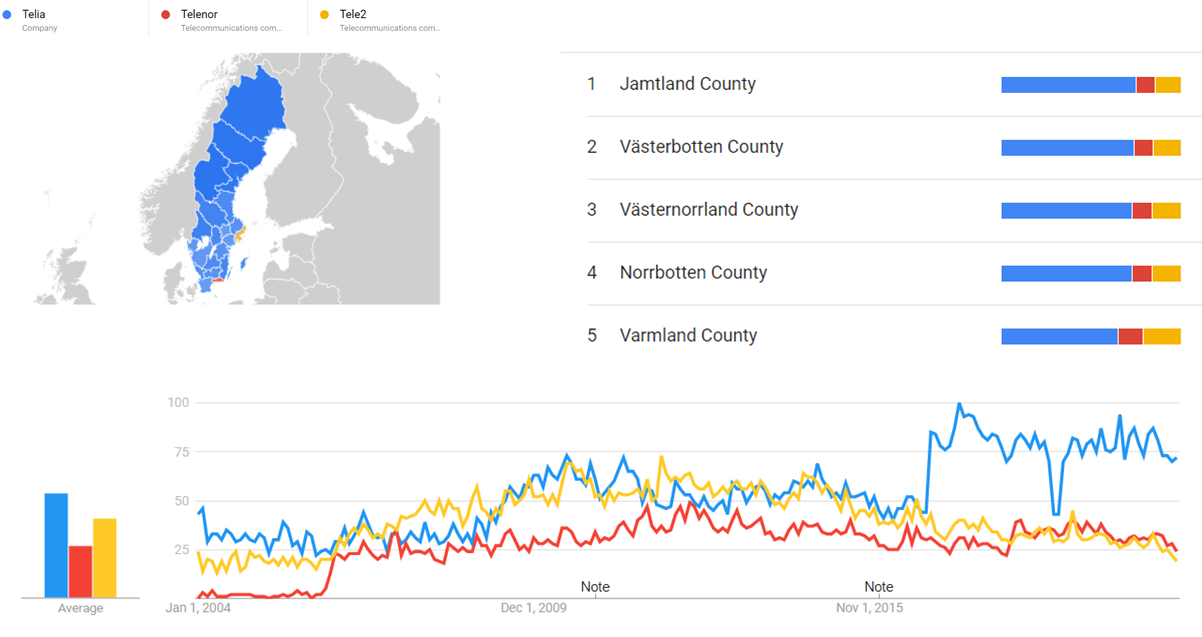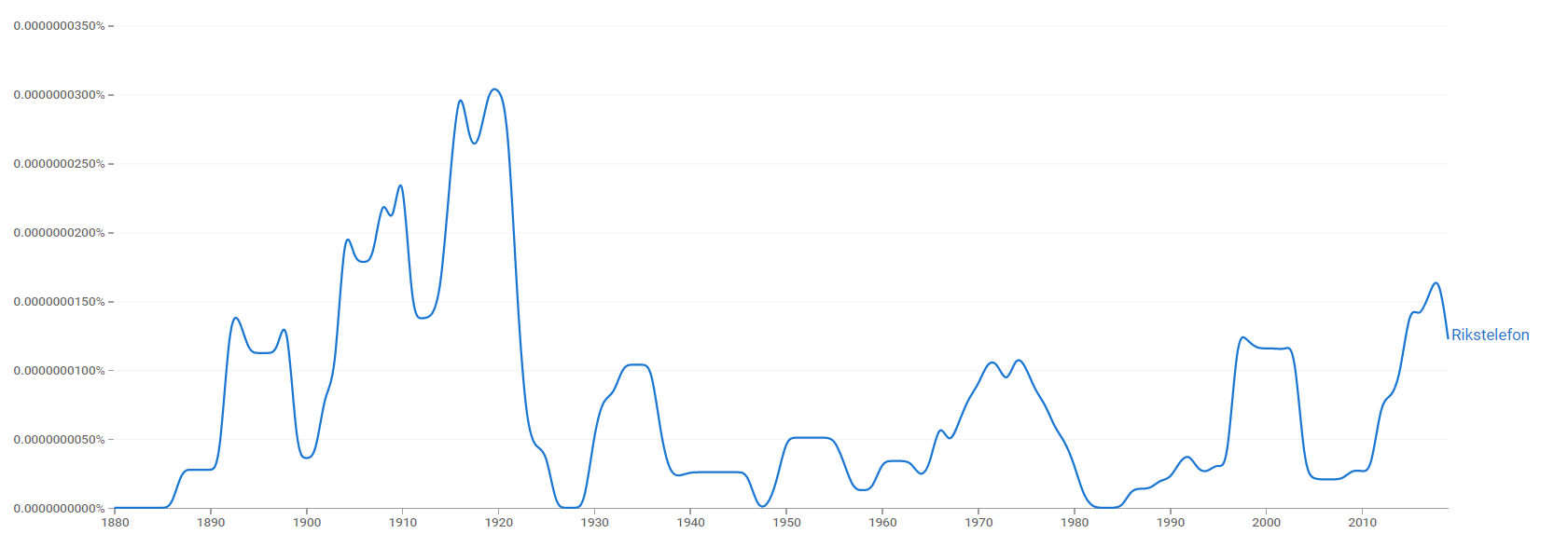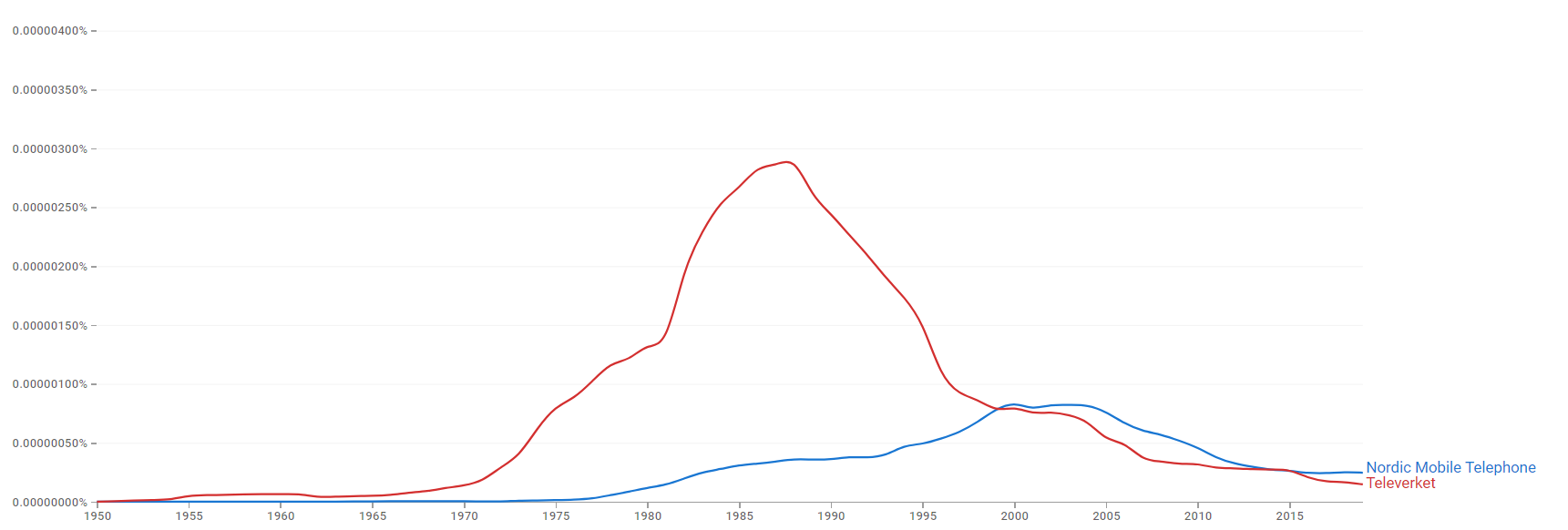Timeline of telephony in Sweden
This is a timeline of telephony in Sweden, attempting to describe major events in the development of the service in the Nordic country.
Big picture
| Time period | Development summary |
|---|---|
| 1880s – 1890s | The Telegraph Administration starts establiching networks all over the country. By the middle of the decade, Stockholm is already Europe’s largest telephone city.[1] Competition between SAT and Telegrafverket turns the Swedish telephon market the most accessible in Europe, with the lowest telephone charges in the continent as well as the highest teledensity.[2] |
| 1950s | A basic system of mobile radiophones starts operating.[3] |
| 1960s | Ericsson releases one of the world's first hands-free speaker telephones.[4] Swedish Telecom is active in promoting international efforts in the ITU to standardise modems intended for sending digital signals as tones over the analogue telephone network.[5] |
| 1970s | The digital era opens up.[5] Ericsson begins testing cellular technology and starts designing equipment that would facilitate commercial service provision in the market.[6] |
| 1980s | The Nordic Mobile Telephone (NMT) network is launched in Sweden and the rest of Scandinavia. It is the first fully automatic cellular phone system. |
| 1990s | Swedish Ericsson becomes a huge global player with an estimated 40% share of the world’s mobile market at its peak. |
Full timeline
| Year | Event type | Details |
|---|---|---|
| 1853 | Organization (government company) | Swedish Telecom is established by the Swedish government as Kongl. Elektriska Telegraf-Verket when an electric telegraph line using the Morse system is opened between Stockholm and Uppsala.[7] |
| 1860 | Organization | Elektriska Telegraf-Verket is renamed Telegrafverket.[7] |
| 1877 | Infrastructure | The first telephone line is installed in the country, only one year after Alexander Graham Bell's invention.[7] |
| 1878 | Technology | Swedish inventor Lars Magnus Ericsson begins making and selling his own telephone equipment. Ericsson would become a major supplier of telephone equipment to Scandinavia.[4] |
| 1879 | Organization | Three telegraph "commissioners" ask for and obtain authority to establish a Stockholm Telephone Company. Hardly been set up, the company would be taken over by the International Bell Company (ITBC) and become Stockholm Bell Telephone Company (SBTC).[8] |
| 1880 | Network | The Stockholm Bell Telephone Company (SBTC) opens the first Swedish telephone exchange in Stockholm (Västerlanggatan) serving 121 subscribers. Over the next year, this installation would be followed by the exchanges of Göteborg, Malmö and Sundsvall, also under auspices of the ITBC.[8] |
| 1880 – 1882 | Organization (company) | A number of private associations form cooperatives to seet up telephone networks in smaller Swedish towns, including Gävle.[8] |
| 1881 | Network | A dedicated telephone network is installed in Stockholm by the Swedish Telegraph Administration, for central government and government agencies use. Local telephone networks are then started by a mix of organizations in the private and the public sectors.[1] |
| 1883 | Organization (Company) | The Stockholm Allmänna Telefonaktiebolag (SAT, Stockholm Public Telephone Company) is founded. This company would begin a strong competition with Telegrafverket.[2] |
| 1884 | Technology | Lars Magnus Ericsson is the first to combine microphone and receiver into a handset extremely convenient for the user. Years later, the handset would become the Ericsson's trademark.[8][9][10][11] |
| 1885 | Statistics | Stockholm has more telephones than any other city in the world.[7] |
| 1889 | Service | Rikstelefon, a long distance service, is initiated by the Swedish Telegraph Administration, with the purpose of linking local telephone networks nationally.[1] |
| 1889 | Network | Telegrafverket extends the Stockholm network and opens it to the public (initially only opened to various ministries).[8] |
| 1890 | Erik Storckenfeldt, a railway man, becomes director general for the Swedish Telegraph Administration. Storckenfeldt would energetically push ahead with Rikstelefon, the national telephone service.[1] | |
| 1893 | Statistics | Over 50 percent of the telephones in Sweden are state owned.[1] |
| 1894 | Revenue | Revenues from the telephone service for the Swedish Telegraph Administration for the first time surpass those from the telegraph service.[1] |
| 1895 | Accessibility | A telephone call is three to seven times more expensive in Great Britain, France, Austria–Hungary, Italy, Spain and Romania than in Sweden.[8] |
| 1902 | Statistics | The share of telephones outside Stockholm is 97 percent at the time.[1] |
| 1905 | Network | After clandestine lines are revealed, permits are issued for telephone lines for local cross border traffic between Tornio in Finland and Haparanda in Sweden.[1] |
| 1907 | Organization (merge) | SAT, Stockholm General Telephone merges its network with Bell Telephone and forms Stockholmstelefon, which operates the major network in the capital. The Telegraph Administration would achieve control of most of the national telephone network but not in Stockholm, where long takeover negotiations fail to reach a result.[1] |
| 1911 | Infrastructure | Wireless telegraphy to shipping in the North Sea is provided by the Swedish Telegraph Administration’s first coastal radio station in Gothenburg.[1] |
| 1916 | Network | A coastal telephone line is established to Tornio at the border with Finland.[1] |
| 1918 | Acquisition | The Swedish Telegraph Administration acquires the Stockholmstelefon’s network. A merger of the two large telephone networks in Stockholm takes place. A national de facto monopoly on telephone service is established.[1] |
| 1920 | Program launch | The Swedish Parliament decides to start automating the telephone call switching, to install a nationwide long distance telephone cable transmission system and to install a transatlantic wireless telegraph station for reliable communications with the United States.[5] |
| 1920 | Network | A link at Swedish border town Haparanda opens telephony to Northern Finland.[5] |
| 1924 | Infrastructure | The first large automatic telephone exchange opens in Stockholm. Equipped with LM Ericsson 500 point selector switches, it is developed from designs by engineers of the Telegraph Administration. A rotary dial is added to the telephones so that subscribers can set up their own calls.[5] |
| 1928 | Network | The first telephone cable across the Baltic Sea via Åland facilitates telephony between Sweden and South and Central Finland.[5] |
| 1934 | Infrastructure | The Swedish Telegraph Administration develops and introduces small crossbar stations. Chosen due to their robustness and little maintenance requirements, the small crossbar stations provide with rural automation to the Swedish telephone network.[5] |
| 1936 | Technology | Sweden introduces marine radio telephony via short wave. It can be connected to the telephone network, so that sailors at sea can call home. Fixed telephone service to most of the world via short wave radio would become possible towards the end of the decade.[5] |
| 1938 | Network | A second telephone cable between Sweden and Finland is installed for the Olympic Games.[5] |
| 1946 | Technology | Telex opens as a new digital service in Sweden which links customer teleprinters through an automatic switched network.[5] |
| 1953 | Organization | The Swedish Telegraph Administration changes its name from Telegrafverket to Televerket (Swedish Telecom) amidst the celebration of its centenary.[5][7] |
| 1956 | Network | Ericcson introduces the world's first fully automatic mobile telephone system in Sweden. Named MTA (Mobiltelefonisystem A), it allows calls to be made and received in a car using a rotary dial.[4] Introduced in Stockholm and Gothenburg, the system would eventually reach 150 subscribers and last until 1969.[5] |
| 1962 | Upgrade | Ericsson upgrades the MTA and the Mobile System B (MTB) is introduced.[4] |
| 1962 | Service | The Datel service is introduced in Sweden, providing modems for the transmission of digital information via the telephone network on leased and switched lines.[5] |
| 1965 | Infrastructure | Fully automatic international telephone traffic is introduced from Sweden to the Nordic countries.[5] |
| 1965 | Service | Data communications service is introduced in Sweden.[7] |
| 1971 | Network | The Mobile System D (MTD) version is launched, opening for several different brands of equipment. The MTD would gain commercial success.[4][5] |
| 1971 | Facility | A joint Nordic satellite station for Intelsat is opened at Tanum Municipality, as part of Intelsat (International Telecommunications Satellite Organization), which owns and operates satellites used for public international telecommunications. Known as the Nordic earth station, it is a joint undertaking between Sweden, Norway, Finland, and Denmark to provide themselves with an international network.[5][7] |
| 1972 | The last manual exchange in the Swedish fixed telephone network is closed at Arjeplog in Lapland. This brings an almost 50 year long automation period to an end. The automation of the electromechanical and analogue telephone system is then completed.[5] | |
| 1979 | Service | Swedish Telecom establishes its own videotext trial service.[7] |
| 1981 | Network | The Nordic Mobile Telephone (NMT) network opens in Sweden and Norway. It is the first fully automatic cellular phone system.[12][13] |
| 1982 (December) | The first official meeting of the GSM group is held at Televerket in Farsta.[14] | |
| 1984 | Policy | Swedish Telecom is separated from the national budget and forced to seek funding on the open market.[7] |
| 1987 | Policy | The European Commission issues a "green paper", establishing the need for a long-term modernization of the European telecom market.[15] |
| 1989 | Policy | The deregulation of the Swedish telecommunications market is virtually completed, with the abolition of Swedish Telecom's monopoly on large and medium-sized PABXs (private automatic branch exchanges). This would result in one of the most open telecommunications markets in the world.[7] |
| 1991 (October) | Organization (company) | Swedish Telecom International AB is formed as a wholly owned subsidiary of Teleinvest AB, which would market the company's international network services.[7] |
| 1992 – 1993 | Swedish Telecom becomes a state-owned limited company.[16] | |
| 1993 | Organization (company) | Televerket becomes Telia AB.[15] |
| 1993 | Organization (company) | Tele2 is founded as a telecom company.[17] |
| 1997 | Statistics | Ericsson has an estimated 40% share of the world’s mobile market, with around 54 million subscribers. The Swedish company becomes a leading player in networks and the production of mobile telephones, sharing top place with Nokia and Motorola during the year.[4] |
| 2000 | After a failed merger with the Norwegian telecom operator Telenor, almost 30% of the Swedish state´s Telia shares are sold on the Stockholm Stock Exchange. | |
| 2003 | Organization (company) | Telia Company AB is founded as a telecom company, merged from Swedish and Finnish telecommunications companies, Telia and Sonera. Headquartered near Stockholm, it has operations in other countries in Northern and Eastern Europe, and in Central Asia and South Asia.[17] |
| 2009 | Network | TeliaSonera introduces the first 4G LTE network in Stockholm.[13] |
Visual data
Google Trends
The comparative chart below shows Google Trends data (Sweden) for Telia (Company), Telenor (Telecommunications company) and Tele2 (Telecommunications company), from January 2004 to April 2021, when the screenshot was taken. Interest is also ranked by state and displayed on map.[18]

Google Ngram Viewer
The chart below shows Google Ngram Viewer data for Rikstelefon, from 1880 to 2019.[19]

The comparative chart below shows Google Ngram Viewer data for Nordic Mobile Telephone and Televerket, from 1950 to 2019.[20]

Meta information on the timeline
How the timeline was built
The initial version of the timeline was written by User:Sebastian.
Funding information for this timeline is available.
What the timeline is still missing
Timeline update strategy
See also
External links
References
- ↑ 1.00 1.01 1.02 1.03 1.04 1.05 1.06 1.07 1.08 1.09 1.10 1.11 "1880 – 1920 Manual telephony". teliacompanyhistory.com. Retrieved 27 October 2017.
- ↑ 2.0 2.1 Huurdeman, Anton A. "The Worldwide History of Telecommunications". Retrieved 21 November 2017.
{{cite journal}}: Cite journal requires|journal=(help) - ↑ Mercer, David. The Telephone: The Life Story of a Technology. Retrieved 22 November 2017.
- ↑ 5.00 5.01 5.02 5.03 5.04 5.05 5.06 5.07 5.08 5.09 5.10 5.11 5.12 5.13 5.14 5.15 5.16 "1920 – 1980 Automatic telephony and broadcasting". teliacompanyhistory.com. Retrieved 28 October 2017.
- ↑ Global Competitiveness of U.S. Advanced-Technology Industries: Cellular Communications (Information Gatekeepers Inc ed.). Retrieved 21 November 2017.
- ↑ 7.00 7.01 7.02 7.03 7.04 7.05 7.06 7.07 7.08 7.09 7.10 "Swedish Telecom". company-histories.com. Retrieved 21 November 2017.
- ↑ 8.0 8.1 8.2 8.3 8.4 8.5 Chapuis, Robert J.; Joel, Amos E. 100 Years of Telephone Switching, Part 1. Retrieved 20 November 2017.
- ↑ "The telephone handset – a successful introduction". ericsson.com. Retrieved 21 November 2017.
- ↑ Chapuis, Robert J.; Joel, Amos E. 100 Years of Telephone Switching, Part 1. p. 124. Retrieved 21 November 2017.
- ↑ "Museo 1884 Ericsson Trade Mark Telephone". classicbuys.net. Retrieved 21 November 2017.
- ↑ "Evolution of Mobile Communication from 1(G) to 4G, 5G, 6G, 7G". vitorr.com. Retrieved 20 November 2017.
- ↑ 13.0 13.1 "Mobile telephone". britannica.com. Retrieved 21 November 2017.
- ↑ "Nordic advantage". teliacompanyhistory.com. Retrieved 30 October 2017.
- ↑ 15.0 15.1 "Liberalization of the telephony markets". teliacompanyhistory.com. Retrieved 27 October 2017.
- ↑ "Effects of research on Swedish Mobile Telephone Developments: THE GSM STORY" (PDF). vinnova.se. Retrieved 20 November 2017.
- ↑ 17.0 17.1 "List of mobile network operators in Sweden". telcomatraining.com. Retrieved 21 November 2017.
- ↑ "Telia, Telenor and Tele2". Google Trends. Retrieved 27 April 2021.
- ↑ "Rikstelefon". books.google.com. Retrieved 27 April 2021.
- ↑ "Nordic Mobile Telephone and Televerket". books.google.com. Retrieved 27 April 2021.